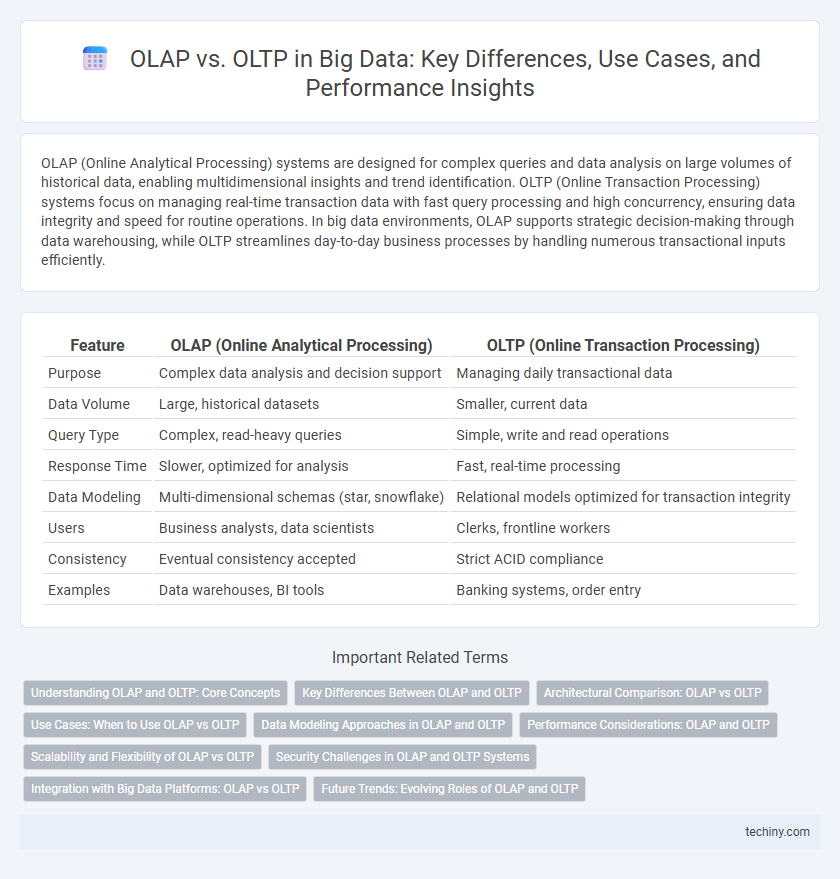OLAP (Online Analytical Processing) systems are designed for complex queries and data analysis on large volumes of historical data, enabling multidimensional insights and trend identification. OLTP (Online Transaction Processing) systems focus on managing real-time transaction data with fast query processing and high concurrency, ensuring data integrity and speed for routine operations. In big data environments, OLAP supports strategic decision-making through data warehousing, while OLTP streamlines day-to-day business processes by handling numerous transactional inputs efficiently.
Table of Comparison
| Feature | OLAP (Online Analytical Processing) | OLTP (Online Transaction Processing) |
|---|---|---|
| Purpose | Complex data analysis and decision support | Managing daily transactional data |
| Data Volume | Large, historical datasets | Smaller, current data |
| Query Type | Complex, read-heavy queries | Simple, write and read operations |
| Response Time | Slower, optimized for analysis | Fast, real-time processing |
| Data Modeling | Multi-dimensional schemas (star, snowflake) | Relational models optimized for transaction integrity |
| Users | Business analysts, data scientists | Clerks, frontline workers |
| Consistency | Eventual consistency accepted | Strict ACID compliance |
| Examples | Data warehouses, BI tools | Banking systems, order entry |
Understanding OLAP and OLTP: Core Concepts
OLAP (Online Analytical Processing) enables complex queries and multidimensional analysis ideal for data warehousing and business intelligence, optimizing read-heavy operations with aggregated historical data. OLTP (Online Transaction Processing) supports real-time transaction processing, focusing on fast, reliable insert, update, and delete operations essential for day-to-day business activities. Understanding their distinct purposes highlights OLAP's role in strategic decision-making versus OLTP's function in operational efficiency.
Key Differences Between OLAP and OLTP
OLAP (Online Analytical Processing) systems are optimized for complex queries and multidimensional analysis of large datasets, supporting strategic decision-making through aggregated historical data. OLTP (Online Transaction Processing) systems focus on managing real-time transactional data with high concurrency, ensuring fast query processing and data integrity for routine operations. Key differences include OLAP's read-intensive workload with complex queries versus OLTP's write-intensive workload with simple queries, along with OLAP's use of data warehouses compared to OLTP's use of normalized databases.
Architectural Comparison: OLAP vs OLTP
OLAP systems utilize a multidimensional architecture optimized for complex analytical queries and data aggregation, enabling fast retrieval of large volumes of historical data. OLTP systems are designed with a relational database architecture focused on high transaction throughput, data integrity, and real-time processing of short, atomic operations. The architectural distinction centers on OLAP's read-intensive, batch processing design versus OLTP's write-intensive, immediate consistency model.
Use Cases: When to Use OLAP vs OLTP
OLAP is ideal for complex analytical queries, multidimensional data analysis, and business intelligence tasks that require aggregating large volumes of historical data. OLTP suits high-transaction environments such as e-commerce platforms, banking systems, and order processing where fast insert, update, and delete operations ensure real-time data consistency. Use OLAP for decision support and trend analysis, while OLTP supports day-to-day operational processing.
Data Modeling Approaches in OLAP and OLTP
OLAP data modeling typically employs a multidimensional schema such as star or snowflake, designed to optimize complex queries and aggregations across large datasets for analytical purposes. OLTP data modeling prioritizes normalization with entity-relationship diagrams to ensure data integrity and efficient transaction processing in real-time environments. The structural differences reflect OLAP's focus on read-heavy operations and OLTP's need for fast, consistent write operations.
Performance Considerations: OLAP and OLTP
OLAP systems are designed for complex queries and large-scale data analysis, prioritizing read-intensive performance with optimized data aggregation and multidimensional calculations. OLTP systems focus on high transaction throughput and low-latency processing, efficiently handling numerous short, write-intensive operations with ACID compliance. Performance considerations highlight OLAP's batch processing suitability for decision support, while OLTP excels in real-time data management for operational tasks.
Scalability and Flexibility of OLAP vs OLTP
OLAP systems provide high scalability by efficiently processing large volumes of complex queries across multidimensional data, enabling advanced analytical capabilities and trend analysis. OLTP systems prioritize fast transaction processing with high consistency but often face scalability challenges when handling massive concurrent operations or extensive data growth. OLAP offers greater flexibility for data exploration and historical summarization, whereas OLTP is optimized for real-time, repetitive transactional workloads with rigid schema requirements.
Security Challenges in OLAP and OLTP Systems
OLAP systems face security challenges primarily due to extensive data aggregation and multidimensional analysis, which increase the risk of unauthorized data exposure and inference attacks. OLTP systems require stringent transaction-level security measures to maintain data integrity and prevent fraud amid high-frequency, concurrent access. Both environments demand robust authentication, encryption, and access control mechanisms tailored to their distinct operational characteristics to safeguard sensitive information effectively.
Integration with Big Data Platforms: OLAP vs OLTP
OLAP systems integrate with Big Data platforms by leveraging distributed processing frameworks like Hadoop and Spark to perform complex, multidimensional queries for advanced analytics and decision support. OLTP systems focus on real-time transaction processing, requiring big data ecosystems to support high-throughput, low-latency data ingestion and consistency using technologies such as NoSQL databases and stream processing tools. The integration of OLAP enables batch analysis on massive datasets, while OLTP integration ensures continuous transactional operations within big data environments.
Future Trends: Evolving Roles of OLAP and OLTP
Future trends in Big Data reveal the evolving roles of OLAP and OLTP with OLAP systems increasingly incorporating real-time analytics and machine learning integration for enhanced decision-making. OLTP platforms are advancing towards handling higher transaction volumes with improved scalability using cloud-native architectures and blockchain technology for secure, transparent operations. Hybrid systems combining OLAP's analytical depth and OLTP's transactional efficiency are emerging to meet the growing demand for instantaneous insight and operational agility.
OLAP vs OLTP Infographic

 techiny.com
techiny.com